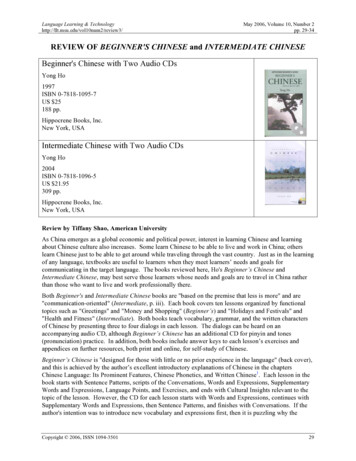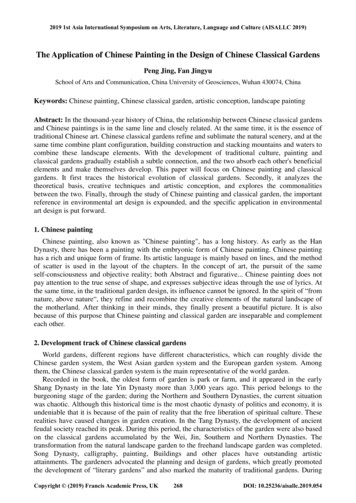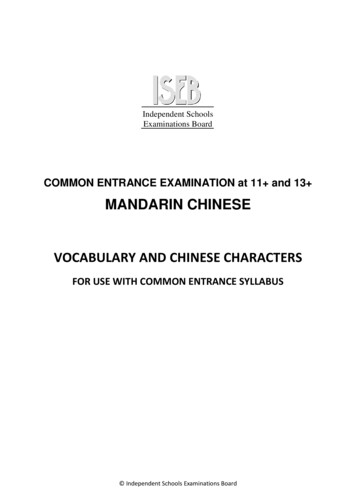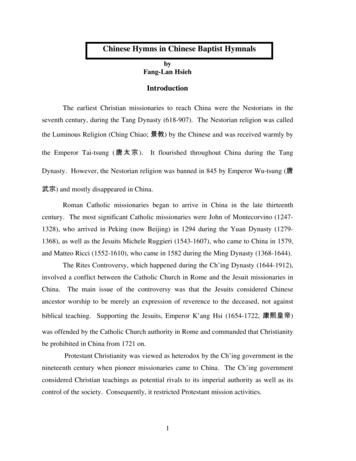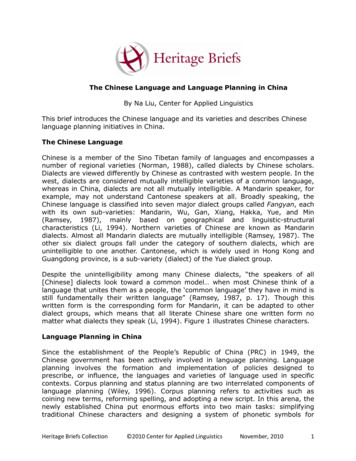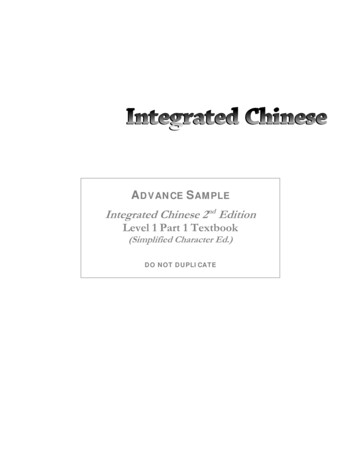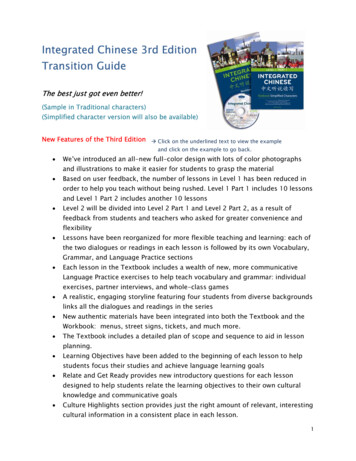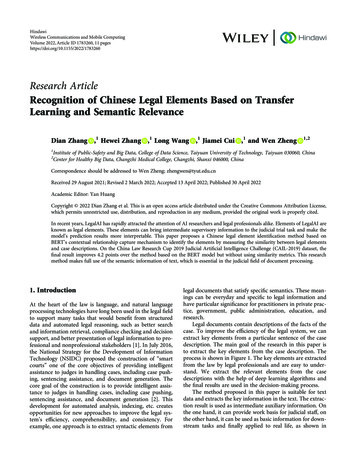
Transcription
HindawiWireless Communications and Mobile ComputingVolume 2022, Article ID 1783260, 11 pageshttps://doi.org/10.1155/2022/1783260Research ArticleRecognition of Chinese Legal Elements Based on TransferLearning and Semantic RelevanceDian Zhang ,1 Hewei Zhang ,1 Long Wang ,1 Jiamei Cui ,1 and Wen Zheng121,2Institute of Public-Safety and Big Data, College of Data Science, Taiyuan University of Technology, Taiyuan 030060, ChinaCenter for Healthy Big Data, Changzhi Medical College, Changzhi, Shanxi 046000, ChinaCorrespondence should be addressed to Wen Zheng; zhengwen@tyut.edu.cnReceived 29 August 2021; Revised 2 March 2022; Accepted 13 April 2022; Published 30 April 2022Academic Editor: Yan HuangCopyright 2022 Dian Zhang et al. This is an open access article distributed under the Creative Commons Attribution License,which permits unrestricted use, distribution, and reproduction in any medium, provided the original work is properly cited.In recent years, LegalAI has rapidly attracted the attention of AI researchers and legal professionals alike. Elements of LegalAI areknown as legal elements. These elements can bring intermediate supervisory information to the judicial trial task and make themodel’s prediction results more interpretable. This paper proposes a Chinese legal element identification method based onBERT’s contextual relationship capture mechanism to identify the elements by measuring the similarity between legal elementsand case descriptions. On the China Law Research Cup 2019 Judicial Artificial Intelligence Challenge (CAIL-2019) dataset, thefinal result improves 4.2 points over the method based on the BERT model but without using similarity metrics. This researchmethod makes full use of the semantic information of text, which is essential in the judicial field of document processing.1. IntroductionAt the heart of the law is language, and natural languageprocessing technologies have long been used in the legal fieldto support many tasks that would benefit from structureddata and automated legal reasoning, such as better searchand information retrieval, compliance checking and decisionsupport, and better presentation of legal information to professional and nonprofessional stakeholders [1]. In July 2016,the National Strategy for the Development of InformationTechnology (NSIDC) proposed the construction of “smartcourts” one of the core objectives of providing intelligentassistance to judges in handling cases, including case pushing, sentencing assistance, and document generation. Thecore goal of the construction is to provide intelligent assistance to judges in handling cases, including case pushing,sentencing assistance, and document generation [2]. Thisdevelopment for automated analysis, indexing, etc. createsopportunities for new approaches to improve the legal system’s efficiency, comprehensibility, and consistency. Forexample, one approach is to extract syntactic elements fromlegal documents that satisfy specific semantics. These meanings can be everyday and specific to legal information andhave particular significance for practitioners in private practice, government, public administration, education, andresearch.Legal documents contain descriptions of the facts of thecase. To improve the efficiency of the legal system, we canextract key elements from a particular sentence of the casedescription. The main goal of the research in this paper isto extract the key elements from the case description. Theprocess is shown in Figure 1. The key elements are extractedfrom the law by legal professionals and are easy to understand. We extract the relevant elements from the casedescriptions with the help of deep learning algorithms andthe final results are used in the decision-making process.The method proposed in this paper is suitable for textdata and extracts the key information in the text. The extraction result is used as intermediate auxiliary information. Onthe one hand, it can provide work basis for judicial staff, onthe other hand, it can be used as basic information for downstream tasks and finally applied to real life, as shown in
2Wireless Communications and Mobile ComputingCase description : The plaintiff sued. In 1983, the plaintiff and the defendant gotmarried. In September 1983, they gave birth to a son. In May 1990, adaughter was born. However, the plaintiff was responsible for allmatters of family life. The defendant often gambled and did not fulfillhis family obligations. Till now, the plaintiff and the defendant havebeen separated for more than eight years. LegalAIThe Court held that themarriage relationshipbetween the plaintiff andthe defendant was a legalmarriage relationship. Theyhad a son and a daughterafter the marriage. Thedefendant did not fulfill isfamily obligations after themarriage and did not fulfillhis responsibilities as ahusband and father. Theyare currently separated fortwo years and theirrelationship has brokendown. Legal regulation :Element :Married withchildrenThe relationship between a parent and childdoes not disappear with divorce. After parentsdivorce, the child remains the child of bothparents.Fulfill familyobligationsDivorce is granted for failure to fulfill familyobligations, abandonment, domestic violence,cohabitation, etc.If you have been separated for two years dueto discord, divorce is granted. Two years ofseparation afterrelationship Figure 1: A block diagram of the proposed research.Query and correspondinganswerLegal knowledge graphLegal textInformationextractionLegal intelligent robotFigure 2: The research results in this paper can eventually be used as supporting information for the construction of the above applicationscenarios. This includes legal intelligent consulting systems and for legal intelligent robots, etc. [3, 4].Figure 2. Furthermore, we outline the application directionsof this study as shown in Figure 3. However, the situation inactual case descriptions is relatively complex. A sample ofdata often expresses multiple semantics of great complexity,and the relevance of sentences and elements in the legaldomain is vital for understanding the interpretation and
Wireless Communications and Mobile Computing3ApplicationsQuestionansweringElements recognitionAssignment of claimsby creditorsReminder of repaymentRefusal to honorrepayments KnowledgeguidedOnline consultationIntelligent voice interactionLaws and regulations predictionJudgmentpredictionPrison term predictionAccusation predictionSimilar casematchingCase retrievalFigure 3: An overview of the application directions of this research.application of the law [5]. In the process of building a “smartcourt,” the element identification task plays an importantrole, aiming to extract key elements from legal documentsautomatically. The purpose is to extract key elements fromlegal documents automatically. For example, “The plaintiffZou Mou A claims: I gave birth to a son named Zou MouB with the defendant Pan Mou on June 6, 2010; on November 1, 2010, both parties registered for divorce and agreedthat The defendant would raise Zou Mou B and I wouldpay monthly alimony,” Support, payment of alimony, andpayment of alimony monthly. This information has a significant reference value for the trial outcome and is critical inthe trial process. Trial experts generate the critical elementsbased on case analysis. The extracted results can be used inpractical operations in the judicial field, such as case summary, interpretable class case push, and related knowledgerecommendation. This paper proposes a new method foridentifying legal elements, which can learn the complexsemantic information in the documents and help uncoverthe key elements of legal documents, and is of outstandingtechnical significance and practical importance for promoting the development of “smart court.”2. Related WorkLegal research is usually the process of finding the information needed to support legal decisions. In practice, this usually means searching for content relevant to the particularmatter at hands [6]. LegalAI also has its exclusive notation,named legal elements. The extraction of legal elementsfocuses on extracting key elements, such as whether someone has been killed or whether something has been stolen.These elements are known as the constituent elements of acrime, and we can directly convict an offender based onthe outcome of these elements. These elements bring intermediate supervisory information to the judgment predictiontask and make the model’s predictions more interpretable.In natural language processing, several classical codingmodels are used to extract features [7–10] and perform ele-ment recognition tasks. They can automatically extract keyinformation from text and apply it to downstream tasks.Typical algorithms include ML-KNN [11] based on theKNN algorithm, ML-DT [12] based on the decision treealgorithm, and Rank-SVM [13] based on the SVM algorithm; Yildirim et al. [14] analyzed text to extract nounphrases from it and trained a support vector machine classifier to determine whether the noun phrases were genuineattributes; Chen et al. [15] compared conditional randomfields with a variety of other methods for element recognition, including hidden Markov models and associationrule-based statistical methods, and the experiments showthat conditional random fields are more suitable for elementrecognition tasks. However, machine learning methods oftenuse phrases as features for classification, ignoring contextualinformation.In recent years, deep learning has achieved perfectresults on text classification task. Kim [16] used theTextCNN method to perform text feature extraction afterobtaining vector representations of text, which can capturelocal semantic information; Liu et al. [17] used the deeplearning method RNN to capture global contextual information by passing information from one moment to the next,which can also achieve good results. However, the positionof words in the sentence in the case description of legal documents has a more critical impact on the case outcome.Although we can capture local or global contextual information by CNN and RNN, we cannot express the positioninformation of words and the interrelationship of otherwords in the text simultaneously [17, 18]. The above algorithms require a large amount of labeled data for trainingand are very costly. To overcome this limitation, a methodcalled “transfer learning” (in this paper, fine-tuning is usedas a transfer learning technique) is introduced in this paper[19, 20]. The basic rule of this approach is to reuse the modeltrained for a specific task as a starting point for the modeltrained for the target downstream task. In the last two tothree years, migration learning has shown extraordinaryresults in most computer vision tasks [21, 22], and in today’s
4Wireless Communications and Mobile ComputingTable 1: Results of elemental analysis.Table 3: Chinese semantic information of character tags.Case description: the plaintiff sued. In 1983, the plaintiff and the defendant gotmarried. In September 1983, they gave birth to a son. In May 1990,a daughter was born. However, the plaintiff was responsible for allmatters of family life. The defendant often gambled and did notfulfill his family obligations. Till now, the plaintiff and thedefendant have been separated for more than eight years. Married with childrenFulfill family obligationsTwo years of separation after discord in a relationshipYesNoYesCase result: (the plaintiff won the case.) divorce grantedTable 2: Sample data.SentenceSentence 1Sentence 2Sentence 3Label list[][“DV1”][“DV1”, “DV4”, “DV2”]practice, researchers rarely train deep learning models fromscratch. Transfer learning, previously restricted to CV tasks,can now also be performed in the natural language processing domain, introducing recent language representationmodels [23–25], and the latest technology, Google’s BERT[26]. Transfer learning performs well in natural languageunderstanding tasks.For the element recognition task of legal documents, thispaper proposes a semisupervised migratory learningapproach based on BERT’s contextual relationship capturingmechanism to accomplish element recognition by measuring the similarity between legal elements and case descriptions. The core idea of this approach is to use the transferlearning capability of the BERT pretrained language modelto represent each sentence of the text and Chinese elementfeatures and finally use cosine similarity to measure the similarity between the sentence feature vector and the Chineseelement feature vector, to predict whether the Chinese labelis a critical element of the text.3. Methods of Legal Element Recognition3.1. Element Recognition. In the judicial domain, the primarypurpose of the case element recognition task is to automatically extract critical factual descriptions from the casedescription. The results of the case element recognition canbe used in practical business requirements in the judicialfield, such as case summaries, interpretable case pushing,and relevant knowledge recommendation. After the relevantparagraph of a given judicial document, the system analyzesand judges each sentence to identify the critical case elements. Table 1 shows that the recognized elements candetermine the final judgment results. It shows that legal elements are important for downstream tasks.Table 2 shows the three sentences in the instrument. It isimportant to note that each sentence in the instrument cor-English charactersDV1DV2DV4Chinese semanticsSemantics1Semantics2Semantics3responds to a variable number of category labels, which maycontain one or more or even no critical elements at all. Thelabels are represented using English characters and have corresponding Chinese semantics, as in Table 3. The Chinesesemantics is given by the relevant experts in the field andis a vital reference for the orientation of judicial outcomes.This task covers three areas in total, including marriageand family, labor disputes, and loan contracts. Before theelement identification task, the English labels in the datasetneeded to be replaced using Chinese labels. The Chinesesemantics of all tags needed to be judged and whether therewas a contextual connection with each sentence. If two sentences are contextually related, they are tagged, indicatingthat the tag belongs to the critical elements of the sentenceand is stored in the list; if it is not tagged, it means thatthe tag does not belong to the critical elements of the sentence and no other processing is done.3.2. BERT Model. The BERT model is a language representation model based on a large amount of unsupervised datatrained by Google released in 2018, using transformer’s powerful information extraction capabilities to build pretrainedlanguage models with strong generalization capabilitiesusing massive amounts of data. The BERT model uses theencoder part of transformer [27], and its model structure isshown in Figure 4.The transformer is a self-attention based model that usesthe encoder-decoder structure in seq2seq, where both theinput and output are sequences. The decoder decodes thisfixed-length vector into a variable-length output sequence.This idea is based on RNNs, unlike RNNs, where thegradient of each input depends not only on the computationof the current step but also on the data of the previous timesteps. Therefore, RNNs have the disadvantage of not beingparallel and running slowly. Elements also take into accountthe relationship between any two elements of the input [28].The structure of the encoder in the transformer model isshown in Figure 5. The input to the encoder is a wordembedding representation of a sentence, which is fed intothe self-attention layer with the location information of eachword in the sentence. Self-attention computes the relationship of each word in a sentence to other words, embeddingthe sema ttend(t.lab)7. Else: Continu8. End for9. Return resultAlgorithm 2: Element identification method for Chinese legal documents.random words 10% of the time, and words remainingunchanged the rest of the time. The model attempts to predict the correct value of the masked words based on the con-text given by the unmasked words in the sequence.Technically speaking, predicting the output words requiresthree steps:
Wireless Communications and Mobile ComputingTable 4: Marriage and family domain element label.Marriage and V11DV12DV13DV14DV15DV16DV17DV18DV19DV20Chinese semanticsMarried with childrenMaintenance of a child with restricted capacityWith a community of propertyPayment of alimonyDivision of real propertyLive apart after marriageSecond divorce proceedingsMonthly child support paymentsGranting of divorceHave joint debts with spousePremarital personal propertyLegal divorceFailure to meet family obligationsExistence of children born out of wedlockAppropriate helpFailure to comply with the divorce agreementCompensation for damagesTwo years of separation after discord in arelationshipThe children live with a non-parentThe personal property after the marriage(1) A classification layer is added to the top of theencoder layer(2) The embedding matrix is multiplied by the outputvector to convert it into the dimensionality of thevocabulary(3) The probability of each word in the vocabulary iscalculated using softmaxMLM captures the relationship between two sentences,vital for questions and answers and natural language inference tasks. To better understand the relationship betweentwo sentences, the BERT authors used next sentence prediction, simply a classification task to discover whether sentence B follows sentence A. 50% of the training exampleswere correct, and the rest were randomly selected to generatea pair of incorrect sentences.3.3. Legal Element Recognition Method. In summary, thispaper proposes a legal element recognition method (BERTLER) based on the BERT model and completes the characterization of text data by using the transfer learning abilityof the BERT model. Then, this paper extracts the elementsof sentences by calculating the cosine similarity of sentencesand elements, as shown in Figure 6. First, we preprocess thelegal documents into a single sentence. Each sentence and allthe elements form a sentence combination. Second, the sentence combinations need to be represented vectorially andby calculating the semantic similarity. We identify the criti-7cal elements of the sentences based on their relevance andfinally output all the key elements of each sentence.The specific process is as follows. Algorithm 1 introducesthe data preprocessing part, and Algorithm 2 introduces themethod proposed in this question.4. Experimentation and Analysis SubheadingsThe results and discussion may be presented separately or inone combined section and may optionally be divided intoheaded subsections.4.1. Experimental Data. The dataset used in this paper isfrom the 2019 China Law Research Cup Judicial ArtificialIntelligence challenge and is selected from legal documentspublicly available on the Chinese judicial documents website. Each row of the data represents the result of a sentenceof a part of a paragraph extracted from a judgment document, as well as a list of the sentence’s element labels. Thethree main areas of adjudication are marriage and family,labor disputes, and loan disputes, with 2,740 cases, including1,269 marriage and family cases, 836 cases of labor disputes,and 635 cases of loan disputes. The data were all annotatedby professionals with a legal background, and each of thethree fields has 20 element labels and the Chinese semanticsthey represent, as shown in Tables 4–6.4.2. Evaluation Indicators. The evaluation metrics used inthis paper include microaverage F1 values and macroaverage F1 values.The F1 value is an indicator that combines P and R andis calculated as follows. Fβ β2 1 P Rβ2 P R:ð1ÞIn particular, at this point, the F value is based on aweighted summation average of P and R. β 0 measuresthe relative importance of R to P and is usually taken to beβ 1, at which point the formula degenerates to the standard F1 value, as shown in the following equation.F1 2 P R:P Rð2ÞMacroaveraged F1 values (“Macro F1”) are obtained byfirst counting the indicator values for each class and thenaveraging them arithmetically over all classes, as shown inthe following equation.Macro F1 1 n 2 P i Ri ,k i 1 Pi Rið3Þwhere “k” is the number of categories, and “i” is the “i”category.The microaverage F1 value (“Micro F1”) is a global confusion matrix created by counting each instance in the dataset without classification and then calculating the
8Wireless Communications and Mobile ComputingTable 5: Labeling of elements in the field of labor disputes.Labor disputeElement 14LB15LB16LB17LB18LB19LB20Chinese semanticsDissolution of labor relationsPayment of wagesPayment of financial compensationFailure to pay total remuneration for workExistence of labor relationsNo labor contract signedSign a labor contractPayment of overtime wagesCompensation for payment of double wages for unsigned labor contractsPaying compensation for injuries at workNot initiated at the labor arbitration stageNon-payment of compensation for unlawful termination of labor relationsEconomic redundanciesNo bonus paymentIllegal collection of property from workersSpecial types of workPayment of death benefits funeral benefits pensionsCancellation by the employer with prior noticeThe legal person status has been lostWith mediation agreementsTable 6: Labeling of elements in the area of borrowing disputes.Borrowing disputesElement 14LN15LN16LN17LN18LN19LN20Chinese semanticsAssignment of claims by creditorsThe amount borrowed x million yuanWith proof of borrowingThe lender has a relationship with the financial institutionRepayment of a loanCompany unit other organizations loansJoint and several warrantiesReminder of repaymentInterest paymentsConclusion of warranty contractsHave a written commitment to repay the loanThe security contract is invalid withdrawal releaseRefusal to honor repaymentsExclusion of the guarantor’s warrantyThe guarantor is not liable for the guaranteeThe pledgee is associated with the companyThe lender does not provide the loan on the agreed date amountMany people borrowingAssignment of debts by the debtorThe agreed interest rate is unknown
Wireless Communications and Mobile Computing9Comparision of score 605550TextCNNDPCNNLSTMBERT-SSBERT-SP BERT-LERModelFigure 7: Comparison of experimental models.Table 7: Comparative results of different methods.ModelDivorceMiF1 MaF1LaborMiF1 MaF1LoanMiF1 5%53.1%39.5%43.7%56.5%corresponding metric, as shown in the following equation.Micro F1 2 Micro P Micro R:Micro P Micro Rð4ÞThe Macro F1 value treats each category equally, so rarecategories mainly influence its value, while the Micro F1value considers each document in the document set equally,so common categories more influence its value. The performance criteria of the model in the 2019 China Law ResearchCup Judicial AI Challenge are evaluated using the score,which is calculated using “Micro F1” and “Macro F1”, asshown in the following equation.Score Macro F1 Micro F1:2ð5Þ4.3. Experimental Results. To verify the effectiveness of thenew method, we conducted six experiments. TextCNN,DPCNN, and LSTM [29] were used as baselines. As shownin Figure 7, the migration learning method is used to achievetext vector representation, and cosine similarity is used toachieve element recognition with good results. The resultsshow that the recognition of Chinese legal elements basedon transfer learning and semantic relevance is feasible forelement recognition in the judicial domain.We conducted experiments using three types of cases inthe judicial field, including 1,269 marriage and family documents, 836 labor dispute documents, and 635 loan disputedocuments. According to Table 7, the prediction results ofmarriage and family documents are good. Although the Bertmodel has strong generalization ability, a lot of data is alsorequired for fine-tuning. In the experimental results,TextCNN performs better, because some elements in thedata sample can be directly extracted by keyword matching.CNN has the ability of local feature extraction, so it has goodperformance in dealing with these problems. However, thegradient will disappear after the LSTM sequence lengthexceeds a certain limit, so it does not achieve the bestperformance.To verify the effectiveness of our method, we conductthree independent experiments based on the BERT model.The first two groups use the two main downstream tasksof BERT, the single-sentence classification task, and thesentence-pair classification task. They use the two maindownstream tasks of BERT, the single-sentence classificationtask, and the sentence-pair classification task. Sentence pairclassification is done by forming sentence pairs for 20 elements in a legal document and determining the contextualrelationship between them. The last set of experiments(BERT-LER) is the method proposed in this paper. AlthoughBERT can learn global semantic information, the learnedfeatures are difficult to map to the correct elements.Although BERT-SP also considers the semantic informationof elements, this is only reflected in the vector representations. As described in the last paragraph of introduction ofBERT model, BERT still matches whether two sentenceshave a contextual relationship by probability in doing thesentence pair matching task. In this paper, however, by
10Wireless Communications an
extract key elements from a particular sentence of the case description. The main goal of the research in this paper is to extract the key elements from the case description. The process is shown in Figure 1. The key elements are extracted from the law by legal professionals and are easy to under-stand. We extract the relevant elements from the .
